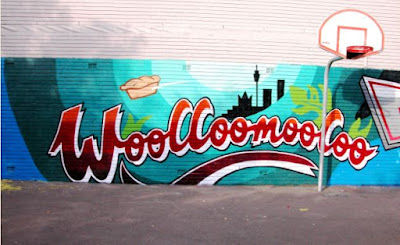Take a walk to some of our favourite murals around Woolloomooloo.
It's not the complete list, so keep your eyes out for others, all along the way.
 |
| Map showing location of murals in this walk |
1. "Support" by Fintan Magee, 2014
At the rear entrance of Plunkett Street School, Dowling Street (near corner of Pring St)
Fintan is considered a leading Australian street artist. He often has images of people being supported. He uses a realistic style with surreal imaginery.
2. Sydney Place mural, 1998
A remarkable series of images, based on Aboriginal artwork and a respect for country.
This artwork was created by artist, Danny Eastwood and produced by the youth and community of Woolloomooloo.
If it seems a bit weary due to age and graffiti, look again and go close up.
Weathering has made them even more beautiful.
3 and 4. The Woolloomooloo History Murals (also called The Green Bans Murals), 1982.
Mounted on the railway overpass pylons.
16 murals were funded by residents to celebrate the success of the "Save the Loo" campaign.
They were designed by artists Merilyn Fairske and Michiel Dolk.
This campaign was waged during the 1970s and backed by Builders Labourers Union Bans.
Labourers simply refused to dismantle old Woolloomooloo. These restrictions were called
"Green Bans" and became a model for citizen action all over the world. At the time, Press, Developers and the NSW Government were happy to vilify them.
Not all the murals can be seen in these locations; over half were removed for preservation.
The ones you can see today celebrate the history and struggle for Woolloomooloo, to stay a suburb
for low income workers. The murals are showing signs of age as the artists wished, but many would like to see them fully restored.
For a look at the complete collection of these murals, see the Art Gallery of New South Wales online
5. Sydney Council basketball courts mural, by artist Sam Maclean, rear PCYC.
This mural was created by the artist working with Woolloomooloo youth. Images of local sport,
bus 311, a flying pie (it can only be a Harry's Cafe de Wheels pie with potato mash) and our
strong southern sun.
6. Stop Valve Espresso and Bar- creatures wrap mural, Riley Street
Cross William Street and walk east, turn right into Riley Street, then head south till you get to this fabulous mural.
Created by street artist, Heesco as an homage to artist Shaun Tan. It shows a big, huggable creature, with octopus legs and shiny black eyes.
Though you could say you are now in East Sydney or Darlo, remember - it was all called Woolloomooloo once.
© Woolloomooloo Insider 2017
Dont miss this other Blog about Sydney history: Sydneyeye













What about the mural inside the school gate, off Best Street? It shows the original 1878 Plunkett Street School with bell-tower. This is not an easy mural to photograph, because the angle through the gate grills is too great. I figure that one of the reasons for photographing them is to keep them in our memory.
ReplyDeleteGood point thanks Julie. I've often looked at this but not been as impressed as I am with the others. But I'm going to go and study it again. As you say, the record is important which is the main reason for including the pylon murals.
Delete